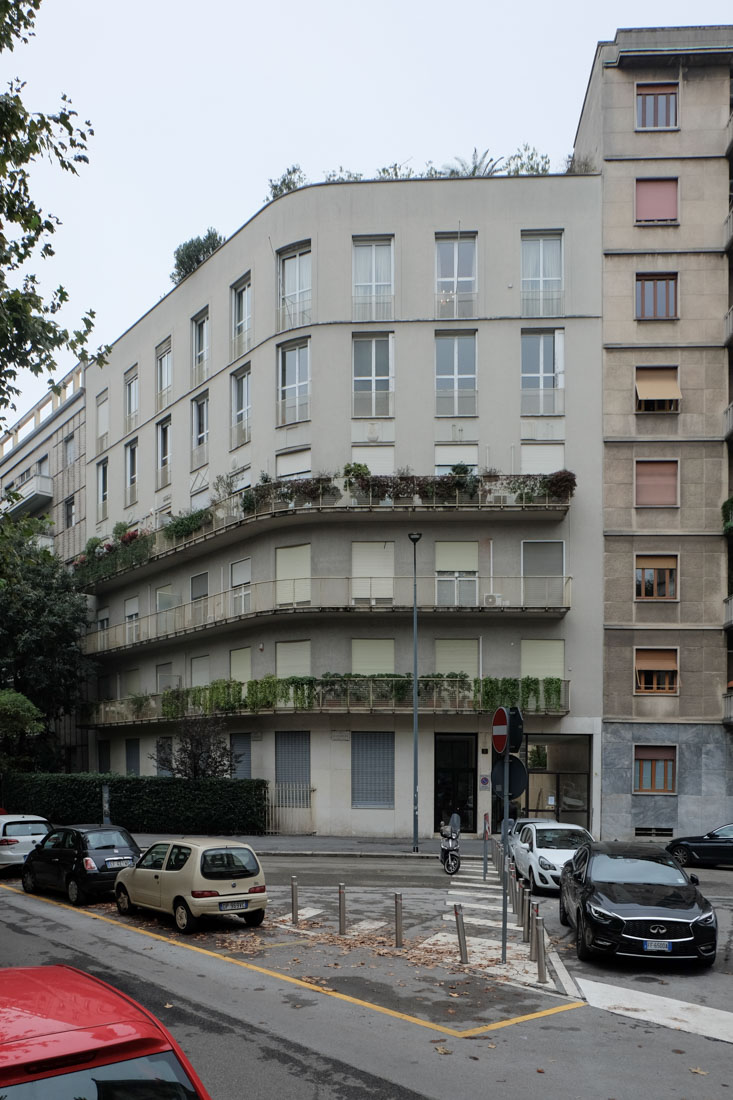 |
 |
 |
 |


Apartment Building Santa Rita
Via Euripide 1-3, Milano
1935 - 1937
The
Santa Rita home is one of the most famous designs from the
early works of Milan architects Mario
Asnago and Claudio Vender.
The apartment building, built between 1935 and 1937, is
located on the
corner of Via Euripide and Viale Cassiodoro on the edge of
the old
Fiera Campionaria district. The building was part of
anextensive urban
planning, which concerned the reconstruction of the world
exhibition
area from 1906. According to the plan, the area was
developed with five
to six-story buildings in relatively high density. The
central themes
of the architectural design are the relationship to the
street front
and the morphology of the city block. Asnago and Vender try
to
determine the properties of the house in a rational way,
always taking
into account the lessons learned from the historic city. The
Santa Rita
building deals with the typological question of the building
inserted
into the block. There are just as many apartments on the six
above-ground floors. Above there is a roof garden and a
large attic,
which is set back from the facade. The modernity of this
design lies in
the search for simple and essential forms, in the reduction
of
historical forms and in the stylization of the decorative
elements. The
homogeneous white coloring of the plaster conceals minimal
geometric
decorations. The curved surface gives the two facades
continuity with a
view of the street. The even openings are regularly
distributed, but
are treated differently at the different levels. This
creates a sifting
of strips lying on top of each other and a subtle division
into three
zones without interrupting the continuity. There are large,
vertical
windows on the top two floors. The three floors below have
slender,
continuous balconies. The windows on the ground floor are
lifted off
the sidewalk with a parapet.
Das Wohnhaus Santa Rita zählt zu den berühmteren Entwürfen aus dem Frühwerk der Mailänder Architekten Mario Asnago und Claudio Vender. Das in den Jahren 1935 - 1937 realisierte Mietshaus befindet sich sich an der Ecke Via Euripide und Viale Cassiodoro am Rande des alten Viertels Fiera Campionaria. Das Gebäude war Teil einer umfassenderen städtebaulichen Planung, welche den Umbau des Weltausstellungsareals von 1906 betraf. Gemäss dem Plan wurde das Gebiet mit fünf- bis sechsstöckigen Gebäuden in relativ hoher Dichte entwickelt. Die zentralen Themen des architektonsichen Entwurfs sind die Beziehung zur Strassenfront und zur Morphologie des Stadtblocks. Asnago und Vender versuchen die Eigenschaften des Hauses auf rationale Weise zu bestimmen, wobei sie stets die Lehren aus der Lehre der historischen Stadt berücksichtigen. Das Santa Rita-Gebäude befasst sich mit der typologischen Frage des in den Block eingefügten Gebäudes. Auf den sechs überirdischen Geschossen befinden sich ebensoviele Wohnungen. Darüber gibt es einen Dachgarten und einen grossen Dachboden, welcher von der Fassade zurückversetzt ist. Die Modernität dieses Entwurfs liegt in der Suche nach einfachen und essenziellen Formen, in der Reduktion historischer Formen und in der Stilisierung der dekorativen Elemente. Die homogene weisse Färbung des Verputzes verbirgt minimale geometrische Verzierungen. Die gekrümmte Oberfläche gibt den beiden Fassaden mit Blick auf die Strasse Kontinuität. Die gleichmässigen Öffnungen sind regelmässig verteilt, werden aber auf den unterschiedlichen Ebenen differenziert behandelt. Dadurch entsteht eine Sichtung übereinander liegender Bänder und eine subtile Aufteilung in drei Zonen, ohne dass dabei die Kontinuität unterbrochen würde. In den beiden obersten Stockwerken gibt es grosse, vertikale Fenster. Die drei Stockwerke darunter weisen schlanke, kontinuierliche Balkone auf. Die Fenster im Erdgeschoss sind mit einer Brüstung vom Trottoir abgehoben.
Das Wohnhaus Santa Rita zählt zu den berühmteren Entwürfen aus dem Frühwerk der Mailänder Architekten Mario Asnago und Claudio Vender. Das in den Jahren 1935 - 1937 realisierte Mietshaus befindet sich sich an der Ecke Via Euripide und Viale Cassiodoro am Rande des alten Viertels Fiera Campionaria. Das Gebäude war Teil einer umfassenderen städtebaulichen Planung, welche den Umbau des Weltausstellungsareals von 1906 betraf. Gemäss dem Plan wurde das Gebiet mit fünf- bis sechsstöckigen Gebäuden in relativ hoher Dichte entwickelt. Die zentralen Themen des architektonsichen Entwurfs sind die Beziehung zur Strassenfront und zur Morphologie des Stadtblocks. Asnago und Vender versuchen die Eigenschaften des Hauses auf rationale Weise zu bestimmen, wobei sie stets die Lehren aus der Lehre der historischen Stadt berücksichtigen. Das Santa Rita-Gebäude befasst sich mit der typologischen Frage des in den Block eingefügten Gebäudes. Auf den sechs überirdischen Geschossen befinden sich ebensoviele Wohnungen. Darüber gibt es einen Dachgarten und einen grossen Dachboden, welcher von der Fassade zurückversetzt ist. Die Modernität dieses Entwurfs liegt in der Suche nach einfachen und essenziellen Formen, in der Reduktion historischer Formen und in der Stilisierung der dekorativen Elemente. Die homogene weisse Färbung des Verputzes verbirgt minimale geometrische Verzierungen. Die gekrümmte Oberfläche gibt den beiden Fassaden mit Blick auf die Strasse Kontinuität. Die gleichmässigen Öffnungen sind regelmässig verteilt, werden aber auf den unterschiedlichen Ebenen differenziert behandelt. Dadurch entsteht eine Sichtung übereinander liegender Bänder und eine subtile Aufteilung in drei Zonen, ohne dass dabei die Kontinuität unterbrochen würde. In den beiden obersten Stockwerken gibt es grosse, vertikale Fenster. Die drei Stockwerke darunter weisen schlanke, kontinuierliche Balkone auf. Die Fenster im Erdgeschoss sind mit einer Brüstung vom Trottoir abgehoben.